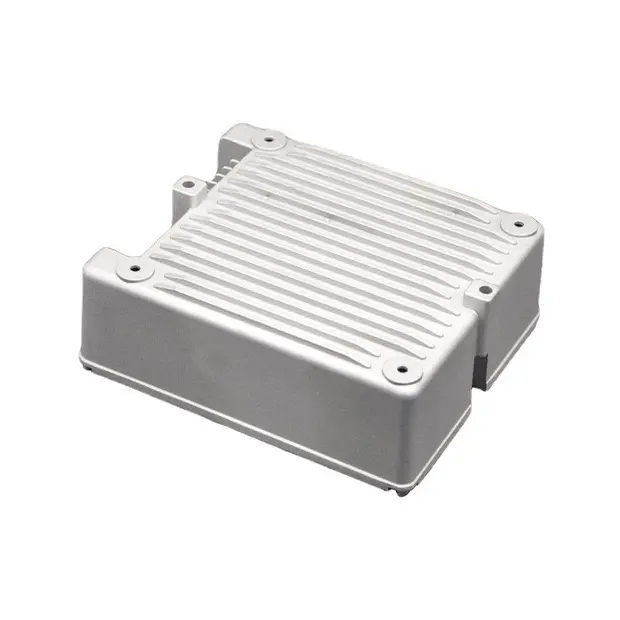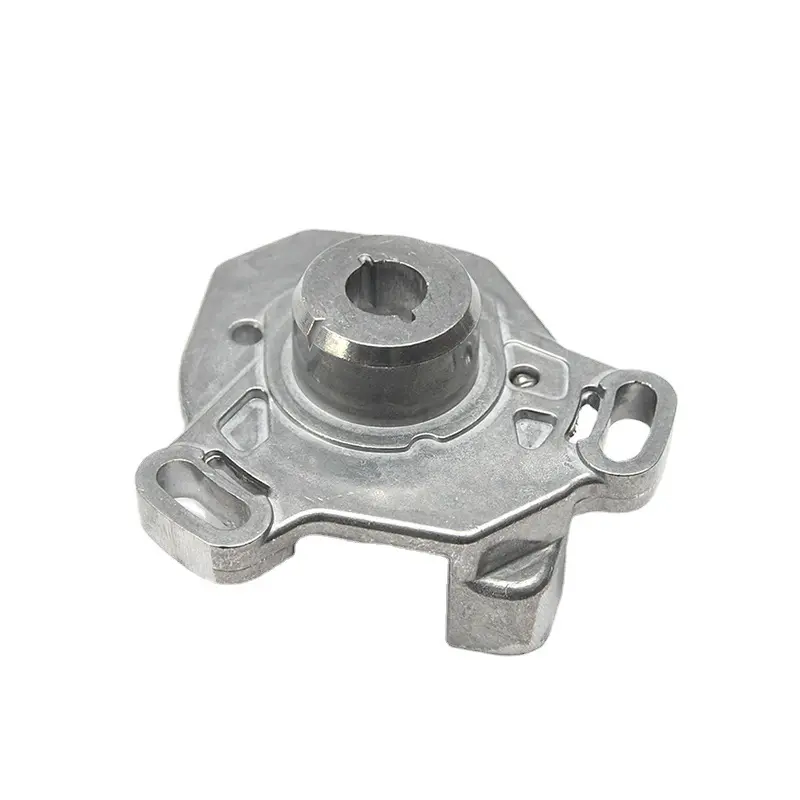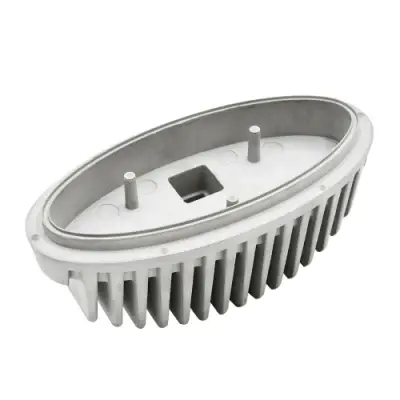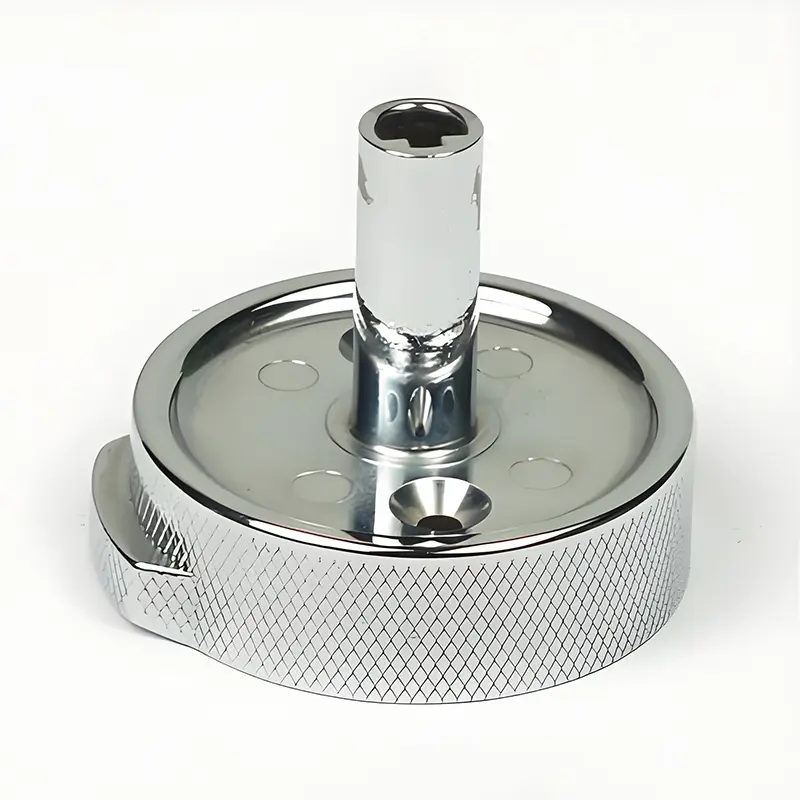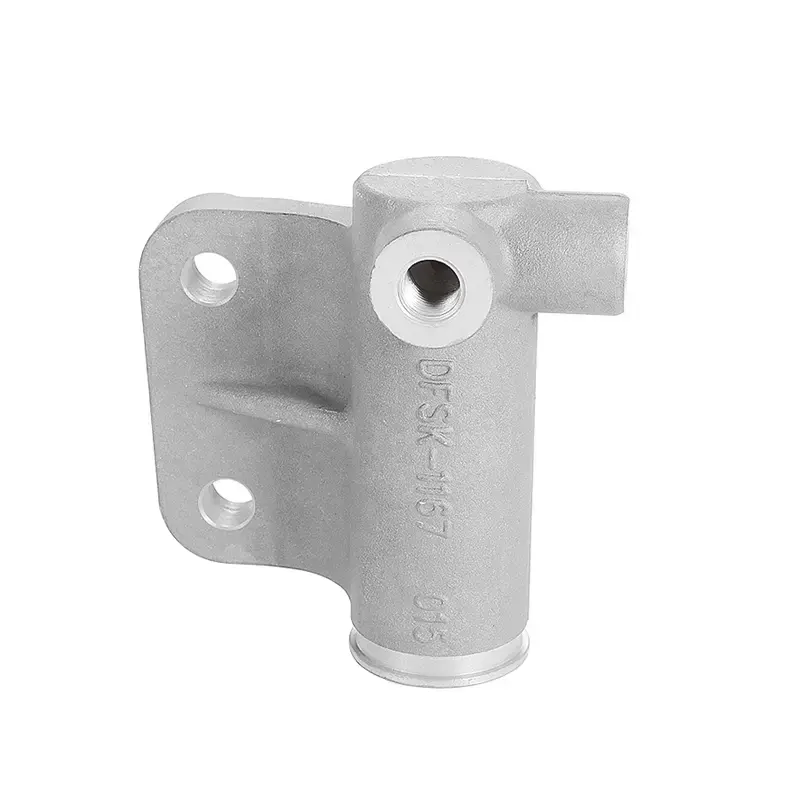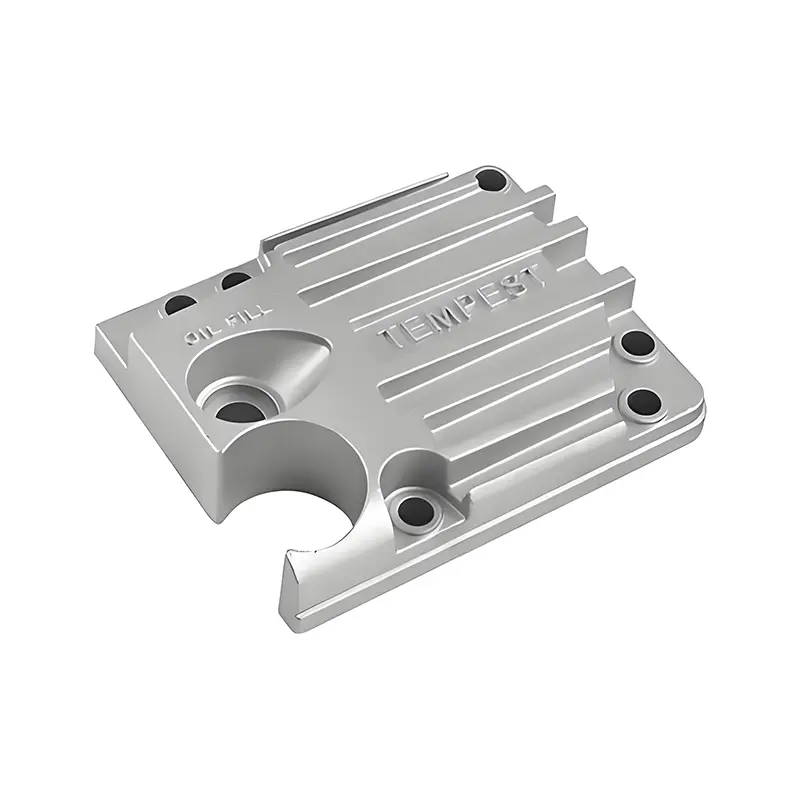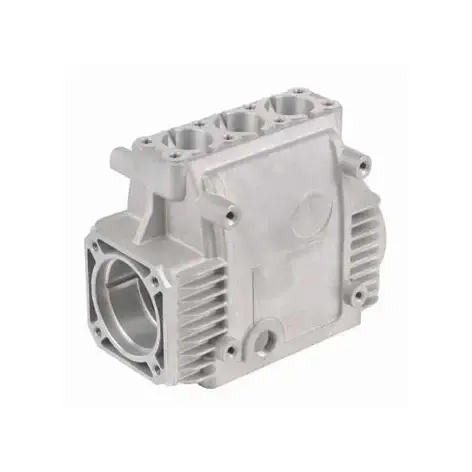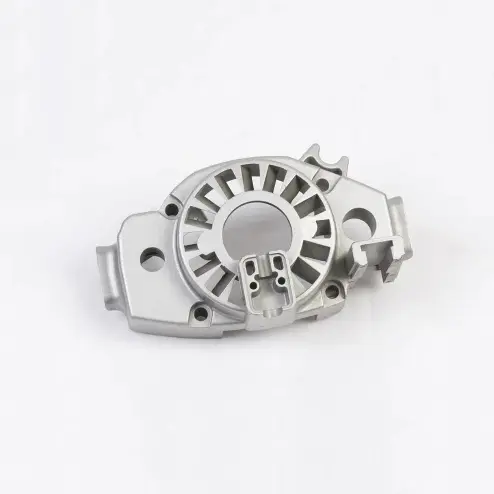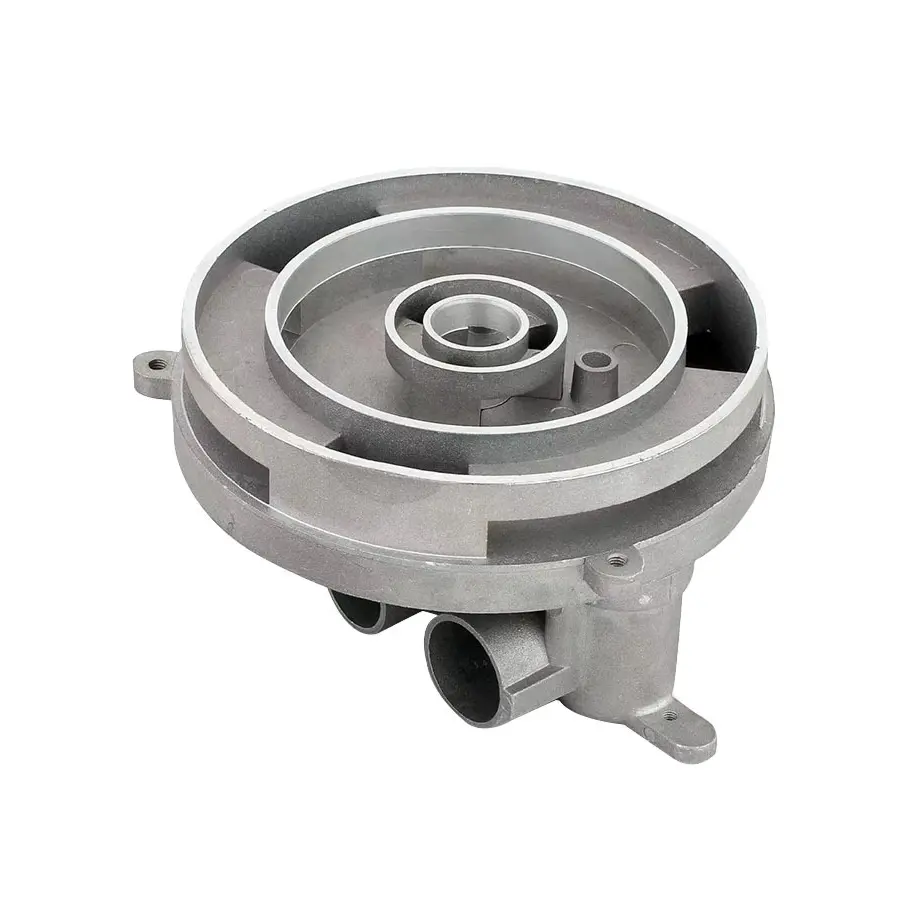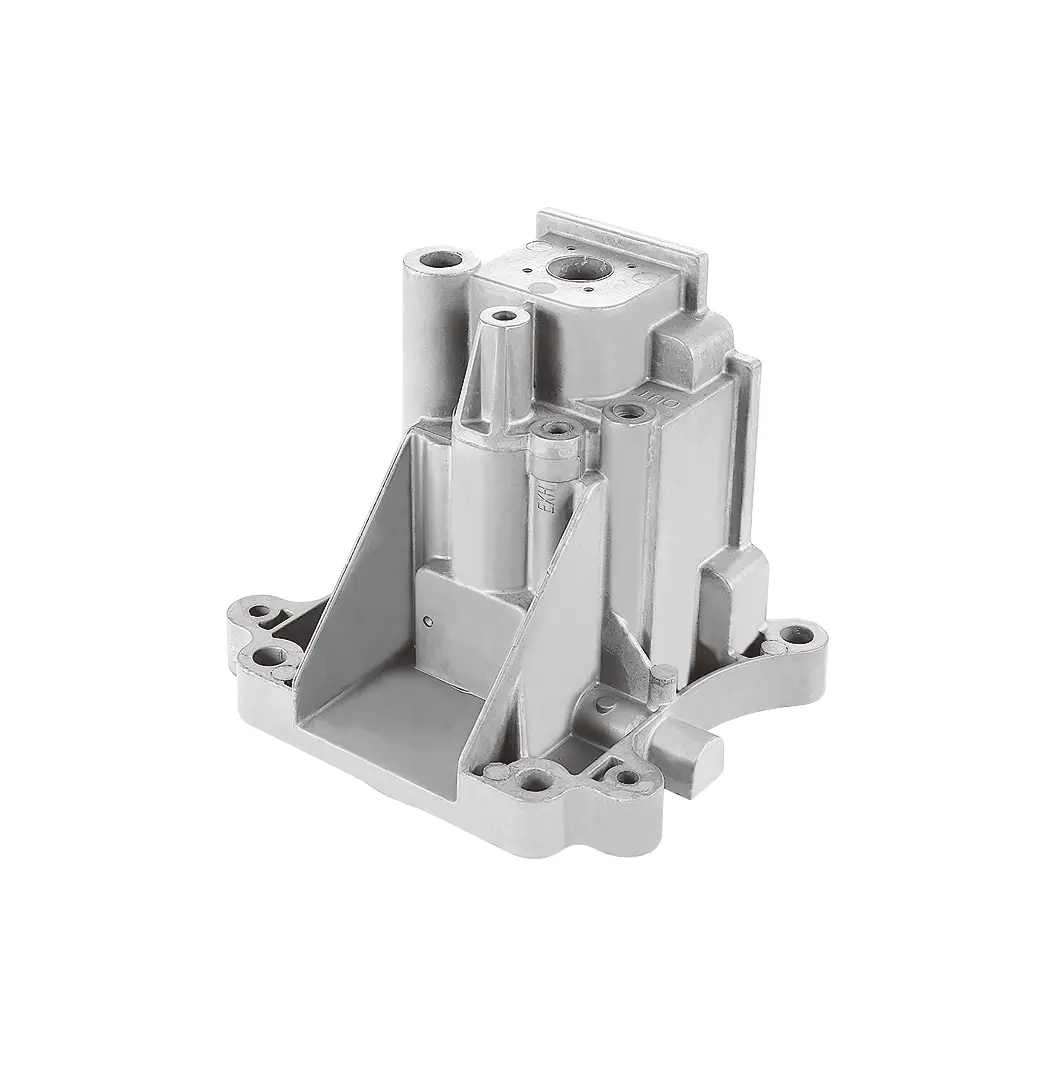 +86-13516964051
+86-13516964051 Aluminum Alloy Gravity Casting
1. Overview of Aluminum Alloy Gravity Casting
1.1 Definition and Principle
Aluminum Alloy Gravity Casting is a Casting Process that uses gravity to make liquid aluminum alloy flow into the mold and solidify under the action of gravity. The basic principle is to heat the aluminum alloy to a molten state, then pour the molten metal into the mold cavity, rely on gravity to make the liquid metal fill every corner of the cavity, and finally cool and solidify in the cavity to form the required casting.
Process flow: The process mainly includes the following key steps: First, put the aluminum alloy raw material into the furnace and heat it until it is completely melted. Usually, the temperature needs to be controlled above 660℃ to ensure that the aluminum alloy is completely melted and the composition is uniform. Subsequently, the molten aluminum alloy liquid is smoothly poured into the pre-prepared mold. The mold can be made of sand, metal or other materials, and its cavity shape matches the shape of the required casting. Under the action of gravity, the aluminum alloy liquid gradually fills the cavity, and the filling speed depends on the structure of the mold and the fluidity of the alloy. When the aluminum alloy liquid fills the mold cavity, the cooling and solidification process begins. This process requires controlling the cooling rate to avoid defects inside the casting. Finally, after the casting is completely solidified, open the mold to take out the casting, and carry out subsequent cleaning and inspection work, including removing the pouring head and cleaning the surface sand, to ensure that the quality of the casting meets the requirements.
Advantages: Aluminum alloy gravity casting has many advantages. First, its equipment is relatively simple, mainly composed of a furnace, a ladle and a Casting Mold, with a low investment cost, suitable for small and medium-sized production. Secondly, the process is relatively simple to operate, easy to master and control, and the technical requirements for operators are relatively low, which is conducive to reducing production costs. In addition, due to the relatively stable filling of the metal liquid during gravity casting, the surface quality of the casting is good and the dimensional accuracy is high, which can meet the production needs of some parts with high requirements for surface quality and dimensional accuracy. For example, in the field of automobile manufacturing, many aluminum alloy wheels are produced by gravity casting, with a smooth surface and dimensional accuracy that can meet the requirements of automobile assembly.
Application areas: Aluminum alloy gravity casting is widely used in automobile, aerospace, machinery manufacturing, electronics and electrical appliances and other industries. In the automotive industry, in addition to wheels, key components such as engine cylinders and transmission housings are also often manufactured using this process. In the aerospace field, some non-load-bearing structural parts such as wing ribs are also produced by gravity casting. In the machinery manufacturing industry, various aluminum alloy castings such as pump housings and valve bodies also use gravity Casting Technology in large quantities. According to statistics, the number of aluminum alloy castings produced by gravity casting worldwide is huge each year, and the annual demand in the automotive industry alone exceeds tens of millions of pieces, which fully reflects the important position and broad application prospects of aluminum alloy gravity casting in industrial production.
2. Process Flow
2.1 Mold Preparation
The preparation of aluminum alloy gravity casting molds is one of the key links in the entire process, which directly affects the quality and production efficiency of castings.
Mold Material Selection: Molds are usually made of materials such as metal or sand. Metal molds have high strength and thermal conductivity, and are suitable for the production of castings with complex shapes and high dimensional accuracy requirements, but the cost is high; sand molds have low costs and good air permeability, and are suitable for the production of large or simple castings. According to statistics, in the production of automobile wheels, the service life of metal molds can reach thousands of times, while the service life of sand molds is relatively short, but the replacement cost is low.
Mold design and manufacturing: The design of the mold needs to be accurately calculated according to the shape and size of the casting to ensure that the molten metal can smoothly fill the cavity and no defects will occur during the cooling process. Modern mold design usually uses computer-aided design (CAD) software to optimize the structure and pouring system of the mold by simulating the flow and cooling process of the molten metal. For example, when designing an engine block mold, through simulation analysis, the location and number of gates can be optimized to make the molten metal fill more evenly and reduce the generation of defects such as pores and slag inclusions.
Mold preheating: Before pouring, the mold needs to be preheated to prevent the molten metal from cooling rapidly when it contacts the cold mold and causing defects such as cold shut. The preheating temperature is generally determined according to the mold material and the size of the casting, usually between 200℃ and 300℃. The preheated mold can keep the molten metal in the cavity with good fluidity and improve the surface quality and dimensional accuracy of the casting.
2.2 Melting and pouring
Melting and pouring are the core links of aluminum alloy gravity casting, which determine the composition uniformity and surface quality of castings.
Melting equipment and process: The smelting of aluminum alloy is usually carried out in a resistance furnace or a gas furnace, and the temperature is controlled at above 660℃ to ensure that the alloy is completely melted and the composition is uniform. The impurity content needs to be strictly controlled during the smelting process, and the oxide and gas impurities in the molten metal are usually removed by adding refining agents. For example, during the smelting process, by adding an appropriate amount of sodium chloride and potassium chloride mixed refining agents, the hydrogen and aluminum oxide impurities in the molten metal can be effectively removed, so that the purity of the molten metal reaches more than 99%.
Control of pouring process: During pouring, the molten metal is poured smoothly from the ladle into the casting cavity, and the pouring speed needs to be adjusted according to the structure of the casting and the fluidity of the alloy. Too fast pouring speed may cause the molten metal to splash and entrain, and too slow pouring speed may cause the molten metal to cool and solidify unevenly in the cavity. Generally speaking, the pouring speed should be controlled between 0.5 and 1.5 m/s. At the same time, the temperature of the molten metal needs to be kept stable during the pouring process to avoid defects inside the casting due to temperature fluctuations.
Pouring system design: A reasonable pouring system design is essential for the smooth filling of the molten metal. The pouring system includes gates, sprues and runners, and its design needs to ensure that the molten metal can be evenly distributed to all parts of the cavity. For example, in the pouring system design of large castings, the use of multi-gate design can effectively improve the filling speed and uniformity of the molten metal and reduce shrinkage and shrinkage defects inside the casting.
2.3 Cooling and demolding
Cooling and demolding are the last links of aluminum alloy gravity casting, which determine the final quality and production efficiency of the casting.
Cooling rate control: The cooling rate has an important influence on the structure and performance of the casting. Rapid cooling can enable the casting to obtain a fine grain structure and improve the strength and hardness of the casting; slow cooling helps to reduce the residual stress inside the casting. In actual production, the cooling rate is adjusted by controlling the temperature and flow rate of the cooling medium. For example, when producing aluminum alloy wheels, a combination of water cooling and air cooling is used to keep the temperature difference between the inside and outside of the casting within a reasonable range during the cooling process to avoid defects such as cracks.
Demolding process: When the casting is completely solidified, demolding is required. During the demolding process, attention should be paid to protecting the surface of the casting to avoid surface damage due to improper operation. For metal molds, a release agent is usually applied to the mold surface to reduce the adhesion between the casting and the mold; for sand molds, the casting is demolded smoothly by vibration or pneumatic devices. According to statistics, the use of a suitable demolding process can improve the surface quality of the casting by more than 20% and reduce the workload of subsequent cleaning and processing.
Subsequent processing: The casting needs to be cleaned and inspected after demolding, including removing the pouring head and cleaning the surface sand. For some castings with special requirements, heat treatment or surface treatment is also required to improve the performance and corrosion resistance of the casting. For example, aluminum alloy castings in the aerospace field usually require solid solution treatment and aging treatment to improve their strength and toughness to meet strict use requirements.
3. Technical characteristics
3.1 Advantages
As a traditional casting process, aluminum alloy gravity casting stands out among many casting methods with its unique technical characteristics and shows significant advantages.
Equipment and cost advantages: The equipment for aluminum alloy gravity casting is relatively simple, mainly including furnaces, ladles and molds, etc., with low investment costs. Compared with complex processes such as high-pressure casting, the purchase and maintenance costs of gravity casting equipment are greatly reduced, which is suitable for small and medium-sized production. For example, for some small foundries, the initial investment of a complete set of gravity casting equipment may be only about 1/3 of that of high-pressure casting equipment, which makes gravity casting have a high penetration rate in small and medium-sized enterprises.
Operation and personnel requirements: The operation of this process is relatively simple, easy to master and control, and the technical requirements for operators are relatively low. Operators can start working after short-term training, which not only reduces the personnel training costs of enterprises, but also improves production efficiency. According to statistics, the training cycle of gravity casting operators is usually 30% to 50% shorter than the training cycle of operators of complex casting processes, which reduces the manpower and time costs of enterprises to a certain extent.
Casting quality and surface accuracy: Since the filling of molten metal is relatively stable during gravity casting, the surface quality of the casting is good and the dimensional accuracy is high. It can meet the production needs of some parts with high requirements for surface quality and dimensional accuracy. For example, in the field of automobile manufacturing, many aluminum alloy wheels are produced by gravity casting, with smooth surface and dimensional accuracy that can meet the requirements of automobile assembly. In actual production, the surface roughness of gravity casting castings can be controlled at a low level, and the dimensional accuracy error range is small, which makes gravity casting have obvious advantages in the production of high-precision parts.
Wide application: Aluminum alloy gravity casting is widely used in automobile, aerospace, machinery manufacturing, electronic and electrical industries. In the automotive industry, in addition to wheels, key components such as engine cylinders and transmission housings are also often manufactured by this process. In the field of aerospace, some non-load-bearing structural parts such as wing ribs are also produced by gravity casting. In the machinery manufacturing industry, various aluminum alloy castings such as pump housings and valve bodies also use gravity casting processes in large quantities. According to statistics, the number of aluminum alloy castings produced by gravity casting is huge every year in the world, and the annual demand in the automotive industry alone exceeds tens of millions of pieces, which fully reflects the important position and broad application prospects of aluminum alloy gravity casting in industrial production.
3.2 Limitations
Although aluminum alloy gravity casting has many advantages, there are also some limitations in practical applications, which limit its application scope and production efficiency to a certain extent.
Limited production efficiency: The production efficiency of gravity casting is relatively low, especially when producing large or complex castings. Because the molten metal relies on gravity to fill the cavity, the filling speed is slow, and it takes a certain amount of time to ensure the quality of the casting during the cooling process. Compared with processes such as high-pressure casting, the production cycle of gravity casting is longer. For example, to produce a large aluminum alloy casting, the production cycle of gravity casting may be 2 to 3 times longer than that of high-pressure casting, which makes the efficiency advantage of gravity casting in large-scale production not obvious.
Difficulty in controlling the internal quality of castings: Although gravity casting can obtain better surface quality, it is difficult to control the internal quality of castings. Due to the slow filling speed of the molten metal, defects such as pores and slag inclusions are easy to occur in the cavity. These defects will affect the mechanical properties and service life of the casting. In actual production, it is necessary to reduce the occurrence of defects by strictly controlling the smelting process, pouring speed and cooling speed, but it is still difficult to avoid them completely. According to statistics, the internal defect rate of gravity casting castings is usually 10% to 20% higher than that of high-pressure casting, which to a certain extent limits its application in the production of parts with extremely high internal quality requirements.
Limited adaptability to large castings: When producing large castings, the limitations of gravity casting are more obvious. Due to the long flow distance of the molten metal, it is easy to produce defects such as cold shut and insufficient pouring in the cavity. In addition, the cooling speed of large castings is slow, which is prone to residual stress and deformation. In order to ensure the quality of large castings, special process measures are required, such as adding insulation risers and optimizing the cooling system, which increases production costs and process complexity. For example, when producing large aerospace structures, gravity casting has high process difficulty and cost, while other casting processes such as low-pressure casting or vacuum casting may be more suitable for producing such large castings.
Poor adaptability to complex-shaped castings: For castings with complex shapes and large differences in wall thickness, gravity casting is prone to defects during filling and solidification. When filling complex cavities, molten metal is prone to defects such as pores, slag inclusions and shrinkage in corners, thin walls and other parts. At the same time, due to the relatively slow cooling rate of gravity casting, castings with large differences in wall thickness are prone to thermal cracks. In actual production, for complex-shaped castings, the scrap rate of gravity casting is relatively high, which limits its application in the production of complex-shaped castings. For example, when producing some mechanical parts with complex internal structures, gravity casting may not meet the quality requirements, and other more advanced casting processes need to be adopted.
4. Application fields
4.1 Automobile industry
Aluminum alloy gravity casting has extremely wide applications in the automobile industry and is one of the indispensable processes for the manufacture of automobile parts.
Wheel manufacturing: Aluminum alloy wheels are important parts of automobiles, and gravity casting is its main production process. According to statistics, about 70% of the aluminum alloy automobile wheels produced worldwide each year use gravity casting technology. Gravity casting can ensure the dimensional accuracy and surface quality of the wheels and meet the strict requirements of automobile assembly. For example, among the aluminum alloy wheels purchased by a well-known automobile brand each year, gravity casting wheels account for up to 80%. These wheels are not only beautiful in appearance, but also have good mechanical properties and corrosion resistance, and can withstand various complex working conditions during the driving process of the car.
Engine block and transmission housing: The engine block and transmission housing are the core components of the automobile, and the strength, stiffness and precision of the materials are extremely high. Aluminum alloy gravity casting can produce high-quality castings that meet the requirements. Taking a certain automobile engine manufacturing company as an example, the engine cylinder block produced by the gravity casting process has a dimensional accuracy error of less than 0.1 mm, low surface roughness, and low internal defect rate, which effectively improves the performance and reliability of the engine. According to statistics, gravity casting products account for more than 60% of the engine cylinder blocks and transmission housings produced by the company each year, providing a strong guarantee for the efficient operation of the car.
Other parts: In addition to the above-mentioned main parts, many other parts of the car, such as brake calipers and steering knuckles, are also often produced by aluminum alloy gravity casting. Although these parts are relatively small, they have equally strict requirements for precision and performance. Gravity casting can meet their production needs and ensure the overall quality and performance of the car. According to industry statistics, in an ordinary car, the number of parts produced by aluminum alloy gravity casting can reach dozens, and the total weight accounts for about 40% of the total weight of automobile aluminum alloy parts, which fully reflects the important position of gravity casting in the production of parts in the automotive industry.
4.2 Aerospace field
In the aerospace field, aluminum alloy gravity casting is mainly used to produce some non-load-bearing structural parts and some key parts.
Wing ribs: Wing ribs are an important part of aircraft wings. Although their main function is to support and connect, they have extremely high requirements for the strength, lightness and precision of the materials. Aluminum alloy gravity casting can produce wing ribs that meet the requirements. For example, the wing ribs produced by an aerospace manufacturing company using gravity casting technology are 30% lighter than those made of traditional materials, with a 20% increase in strength and a dimensional accuracy error within 0.05 mm, which effectively improves the fuel efficiency and flight performance of the aircraft. According to statistics, gravity casting products account for 50% of the wing ribs produced by the company each year, providing important technical support for the development of the aerospace field.
Engine parts: In aerospace engines, some non-critical parts such as engine covers and air intakes are also produced using aluminum alloy gravity casting technology. Although these parts are not the core components of the engine, they also have an important impact on the overall performance and reliability of the engine. Gravity casting can ensure its surface quality and dimensional accuracy, meeting the strict requirements of aerospace engines. For example, the engine cover produced by a certain aircraft engine manufacturing company using gravity casting technology has a smooth surface and high dimensional accuracy. It can effectively protect the internal components of the engine, while reducing the weight of the engine and improving the performance of the engine. According to statistics, gravity casting products account for about 30% of the engine parts produced by the company each year, providing a reliable guarantee for the manufacture of aerospace engines.
Other structural parts: There are many other structural parts in the aerospace field, such as seat frames, luggage racks, etc., which are also produced using aluminum alloy gravity casting technology. Although these parts are relatively small, they have equally strict requirements for precision and quality. Gravity casting can meet their production needs and ensure the overall quality and performance of aerospace products. According to industry statistics, in a large passenger aircraft, the number of parts produced using aluminum alloy gravity casting technology can reach hundreds, and the total weight accounts for about 20% of the total weight of aircraft aluminum alloy parts, which fully reflects the important role of gravity casting in the production of parts in the aerospace field.
4.3 Other fields
In addition to the automotive and aerospace fields, aluminum alloy gravity casting is also widely used in many fields such as machinery manufacturing, electronics and electrical appliances, and architectural decoration.
Mechanical manufacturing field: In the mechanical manufacturing industry, various aluminum alloy castings such as pump housings, valve bodies, gear boxes, etc. are produced in large quantities using gravity casting technology. Taking a certain mechanical manufacturing enterprise as an example, the pump housing it produces adopts gravity casting technology, which has high dimensional accuracy, good surface quality, and low internal defect rate, and can meet the strict requirements of mechanical manufacturing for parts. According to statistics, gravity casting products account for more than 70% of the aluminum alloy castings produced by the enterprise each year, providing important support for the production and development of the mechanical manufacturing industry.
Electronic and electrical field: In the electronic and electrical industry, aluminum alloy gravity casting is mainly used to produce some parts such as housings and brackets. Although these parts have relatively low strength requirements, they have high requirements for surface quality and dimensional accuracy. Gravity casting can meet its production needs and ensure the appearance quality and performance of electronic and electrical products. For example, the electronic equipment housing produced by a certain electronic equipment manufacturing enterprise using gravity casting technology has a smooth surface and high dimensional accuracy. It can effectively protect the internal electronic components and improve the appearance of the product. According to statistics, gravity casting products account for 60% of the electronic equipment housings produced by the enterprise each year, providing a reliable guarantee for the development of the electronic and electrical industry.
Architectural decoration field: In the field of architectural decoration, aluminum alloy gravity casting is mainly used to produce some decorative parts such as door and window frames, railings, decorative columns, etc. These parts have extremely high requirements for surface quality and need to have good appearance and corrosion resistance. Gravity casting can produce castings with smooth surface and precise dimensions to meet the needs of architectural decoration. For example, the aluminum alloy door and window frames produced by a certain architectural decoration company using gravity casting technology have smooth surface, uniform color, high dimensional accuracy, and can be perfectly integrated with the overall style of the building, improving the beauty and grade of the building. According to statistics, gravity casting products account for about 50% of the architectural decoration aluminum alloy castings produced by the company each year, providing important technical support for the development of the architectural decoration industry.
5. Quality control
5.1 Defect types
Various defects may occur in the process of aluminum alloy gravity casting, which have a significant impact on the quality and performance of the castings. Common defect types include:
Blowholes: This is caused by the metal liquid being entrained in air during the pouring process or the gas in the mold not being discharged in time. The presence of blowholes will reduce the strength and density of the casting. According to statistics, the incidence of porosity defects in gravity castings is about 15% to 20%. For example, in the production of automobile engine cylinder blocks, porosity defects may cause engine coolant leakage, affecting the normal operation of the engine.
Slag inclusion: Slag inclusion is formed when impurities or oxides in the molten metal are not completely removed and remain inside the casting. Slag inclusion reduces the mechanical properties and corrosion resistance of the casting. In actual production, the incidence of slag inclusion defects is about 10% to 15%. For example, in aluminum alloy castings in the aerospace field, slag inclusion defects may cause fatigue fracture of parts during use, seriously affecting flight safety.
Shrinkage and shrinkage: These defects are formed due to the volume shrinkage of the molten metal during cooling and solidification. Shrinkage usually occurs in the thick wall part of the casting, while shrinkage is distributed inside the casting. Shrinkage and shrinkage reduce the strength and toughness of the casting. In gravity casting, the incidence of shrinkage and shrinkage is about 10% to 15%. For example, in the production of large aluminum alloy wheels, shrinkage cavities and shrinkage defects may cause cracks in the wheels when they are under high load, affecting the safety of automobile driving.
Cold shut: Cold shut is formed when the molten metal fails to fully fuse when filling the cavity. This defect usually occurs in the thin-walled part of the casting or at the corner of the cavity. Cold shut reduces the strength and integrity of the casting. In gravity castings, the incidence of cold shut is about 5% to 10%. For example, when producing aluminum alloy parts with complex shapes, cold shut defects may cause parts to break during use, affecting the reliability of the product.
Surface defects: including sand holes, sand adhesion, surface roughness, etc. These defects mainly affect the appearance quality and dimensional accuracy of the casting. In actual production, the incidence of surface defects is about 10% to 15%. For example, in the production of automobile wheels, surface defects will affect the appearance quality of the wheels and reduce the market competitiveness of the products.
5.2 Detection method
In order to ensure the quality of aluminum alloy gravity castings, a variety of detection methods are required to conduct comprehensive inspections of the castings. Common inspection methods include:
Appearance inspection: Check the surface of the casting with the naked eye or a magnifying glass, mainly to detect surface defects such as sand holes, sand adhesion, surface roughness, etc. Appearance inspection is a simple and low-cost inspection method that can quickly detect obvious surface defects. According to statistics, about 80% of surface defects can be found through appearance inspection.
Dimension inspection: Use measuring tools such as calipers and micrometers to measure the dimensions of the casting to ensure that it meets the design requirements. Dimension inspection is an important part of ensuring the accuracy of castings. In actual production, the accuracy of dimensional inspection can reach 0.01 mm, which can effectively control the dimensional error of the casting.
Non-destructive testing:
Ultrasonic testing: Use the propagation characteristics of ultrasonic waves in metals to detect whether there are defects inside the casting. Ultrasonic testing can detect defects such as pores, slag inclusions, shrinkage cavities and shrinkage inside the casting, and the detection depth can reach 80% to 90% of the thickness of the casting. For example, in the inspection of aluminum alloy castings in the aerospace field, ultrasonic testing is a commonly used method that can effectively detect internal defects and ensure the quality and safety of castings.
X-ray inspection: X-rays penetrate castings to form images and detect defects inside castings. X-ray inspection can clearly show defects such as pores and slag inclusions inside castings, with high detection accuracy, and is suitable for detecting small or thin-walled castings. According to statistics, X-ray inspection can detect about 90% of internal defects.
Magnetic particle inspection: Suitable for detecting defects on the surface or near the surface of castings. By applying a magnetic field on the surface of the casting, the magnetic powder is adsorbed at the defect, thereby detecting defects. Magnetic particle inspection has a high detection sensitivity for defects such as surface cracks, and can detect cracks with a width of only 0.01 mm.
Mechanical property inspection: Through tensile tests, hardness tests and other methods, the strength, hardness and other mechanical properties of castings are tested. Mechanical property testing is an important means to evaluate whether castings meet the requirements of use. For example, in the production of automobile engine cylinders, mechanical property testing can ensure that castings can withstand various stresses during engine operation.
Metallographic inspection: Through metallographic analysis, the microstructure of the casting is observed and its grain size, phase composition, etc. are evaluated. Metallographic testing can help analyze the internal quality of castings and provide a basis for process improvement. For example, in the production of aluminum alloy wheels, metallographic testing can optimize the cooling rate, control the grain size, and improve the strength and toughness of castings.
6. Development Trends
6.1 Technological Innovation
Aluminum alloy gravity casting technology has made significant progress in recent years, and there is still broad room for development in the future.
Automation and intelligence: With the continuous development of industrial automation technology, the automation level of aluminum alloy gravity casting will continue to improve. Robot technology will be widely used in smelting, pouring, cooling and demoulding to improve production efficiency and the stability of casting quality. For example, the automatic pouring system can automatically adjust the pouring speed and temperature according to the structure of the mold and the fluidity of the alloy, reducing the impact of human factors on the quality of castings. At the same time, with the help of intelligent sensors and data analysis technology, key parameters in the casting process, such as molten metal temperature, pouring speed, cooling speed, etc., can be monitored in real time, and precise control of the casting process can be achieved through feedback control, further improving the quality and performance of castings.
New materials and new processes: The research and development of high-performance aluminum alloy materials and new casting processes are important directions for the innovation of aluminum alloy gravity casting technology. New aluminum alloy materials will have higher strength, better toughness and better corrosion resistance, and can meet the strict requirements of high-end fields such as aerospace and automobiles for the performance of parts. For example, the application of some new high-strength aluminum alloys in the aerospace field can significantly reduce the weight of aircraft and improve fuel efficiency. In addition, new casting processes such as semi-solid casting and vacuum gravity casting are also emerging. Semi-solid casting can be carried out at a lower temperature to reduce the oxidation and slag inclusion of the molten metal and improve the internal quality of the casting; vacuum gravity casting can effectively reduce defects such as pores and slag inclusions in the casting by casting in a vacuum environment, and improve the density and mechanical properties of the casting.
Digitalization and simulation: The application of digital technology in aluminum alloy gravity casting will become more and more extensive. Computer-aided design (CAD), computer-aided engineering (CAE) and computer-aided manufacturing (CAM) and other technologies will run through the entire casting process, from mold design, smelting process optimization to casting quality prediction and production process control. Through simulation technology, the casting process can be simulated and optimized in a virtual environment, the flow, solidification and cooling process of the molten metal can be predicted, possible defects can be discovered in advance, and casting process parameters can be optimized. For example, using CAE software to simulate the cooling process of large aluminum alloy castings can optimize the design of the cooling system, reduce the residual stress and deformation inside the castings, and improve the quality and dimensional accuracy of the castings. The application of digital technology will greatly improve the production efficiency and product quality of aluminum alloy gravity casting, reduce production costs and scrap rates.
6.2 Market Prospects
As a mature casting process, aluminum alloy gravity casting will still have broad market prospects in the future.
Steady growth in demand in the automotive industry: With the continuous development of the global automotive industry, the demand for aluminum alloy parts will continue to increase. Aluminum alloys have the advantages of low density, high strength, and good corrosion resistance. They can effectively reduce the weight of automobiles, improve fuel efficiency, and reduce exhaust emissions, which is in line with the development trend of the automotive industry. For example, key components such as automobile engine cylinders, transmission housings, and wheels are increasingly made of aluminum alloy materials. According to statistics, the global automotive aluminum alloy parts market will grow at an annual rate of 5% to 8% in the next few years, which will bring stable market demand to the aluminum alloy gravity casting industry.
Huge demand potential in the aerospace field: The aerospace field has extremely high requirements for the performance of materials, and aluminum alloys have broad application prospects in this field. With the continuous advancement of aerospace technology, the demand for lightweight and high-performance aluminum alloy parts will continue to increase. For example, aircraft wing ribs, engine parts, seat frames and other parts are manufactured using aluminum alloy gravity casting technology, which can effectively reduce the weight of the aircraft and improve fuel efficiency and flight performance. In addition, with the rise of commercial aerospace and the deepening of space exploration, the demand for aluminum alloy parts will further increase, providing new market opportunities for the aluminum alloy gravity casting industry.
Emerging fields bring new opportunities: In addition to the traditional automotive and aerospace fields, aluminum alloy gravity casting also has broad application prospects in emerging fields such as new energy vehicles, rail transit, electronics and electrical appliances, and architectural decoration. The development of new energy vehicles has a more urgent demand for lightweight parts, and aluminum alloy gravity casting can meet its requirements for part quality and performance. In the field of rail transit, the application of aluminum alloy car bodies and parts is also becoming more and more extensive, providing new market space for the aluminum alloy gravity casting industry. The rapid development of the field of electronics and electrical appliances has continuously increased the demand for aluminum alloy housings, brackets and other parts, and the demand for aluminum alloy door and window frames, railings and other decorative parts in the field of architectural decoration has also continued to grow. The development of these emerging fields will bring new growth points to the aluminum alloy gravity casting industry.
Sustainable development and environmental protection requirements: With the global attention to environmental protection and sustainable development, the aluminum alloy gravity casting industry will also face new challenges and opportunities. Aluminum alloy is a recyclable material, and its recycling can effectively reduce resource waste and environmental pollution. In the future, aluminum alloy gravity casting companies will pay more attention to energy conservation and emission reduction and resource recycling, adopt more environmentally friendly smelting processes and casting equipment, and reduce energy consumption and exhaust emissions. At the same time, with the increasingly stringent environmental protection regulations, the aluminum alloy gravity casting industry will also usher in new development opportunities and promote the industry to develop in a green and sustainable direction.
7. Summary
Aluminum alloy gravity casting, as a casting process with a long history and wide application, still has an irreplaceable and important position in modern industrial production. Through in-depth research on its process flow, technical characteristics, application fields and quality control, we can fully understand its advantages and limitations, and look forward to its future development trends.
Aluminum alloy gravity casting plays an important role in many fields such as automobiles, aerospace, machinery manufacturing, and electronic appliances with its advantages of simple equipment, low cost, easy operation, good casting surface quality, high dimensional accuracy and wide application. Especially in the automotive industry, gravity casting technology has a dominant position in the production of key parts such as wheel hubs, engine cylinders, and transmission housings; in the aerospace field, despite the extremely high requirements for material performance, gravity casting can still be used to produce some non-load-bearing structural parts and some key parts, such as wing ribs, engine hoods, etc.; in the fields of mechanical manufacturing and electronic appliances, various aluminum alloy castings such as pump housings, valve bodies, and electronic equipment housings are also produced in large quantities using gravity casting technology, which fully reflects its wide application prospects in different fields.
However, gravity casting also has some limitations, such as relatively low production efficiency, especially when producing large or complex castings; it is difficult to control the internal quality of castings, and it is easy to have defects such as pores, slag inclusions, shrinkage cavities, shrinkage, cold shuts, etc., which affect the mechanical properties and service life of castings; the adaptability to large castings and complex-shaped castings is limited, and special process measures are required to ensure quality, which increases production costs and process complexity. These limitations have limited its application scope and production efficiency in some high-end fields to a certain extent.
In order to overcome these limitations, aluminum alloy gravity casting technology has been continuously innovated and developed. The application of automation and intelligent technology will improve production efficiency and the stability of casting quality; the research and development of new materials and new processes will improve the performance and quality of castings; the integration of digitalization and simulation technology will optimize casting process parameters and reduce production costs and scrap rates. At the same time, with the continuous development of traditional fields such as automobiles and aerospace, and the growing demand in emerging fields such as new energy vehicles, rail transportation, electronics and electrical appliances, and architectural decoration, the aluminum alloy gravity casting industry will usher in a broad market prospect. In addition, the global emphasis on environmental protection and sustainable development will also promote the aluminum alloy gravity casting industry to develop in a green and sustainable direction.
In summary, aluminum alloy gravity casting has an important position and broad application prospects in modern industrial production. Through technological innovation and process improvement, its production efficiency and casting quality can be further improved, its application range in high-end fields can be expanded, and the high-quality demand for aluminum alloy parts in different industries can be met. In the future, the aluminum alloy gravity casting industry will continue to make new breakthroughs in technological innovation, market expansion and sustainable development, and make greater contributions to industrial production and social development.








